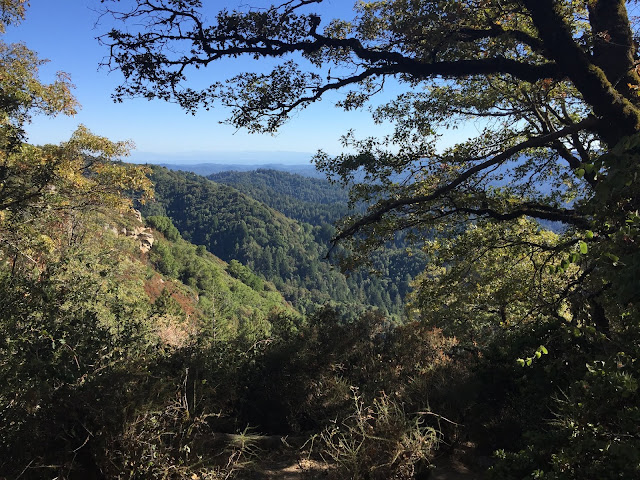Skyline Ridge Open Space Preserve Hike (May 12, 2019 Sunday) + BONUS: Carnivorous Thistle - What????
In the cities - the busy, buzzing metropolis in the Bay Area - it is easy to find grasses turn golden, wild pea plants (Lathyrus) begin to dry and turn dark brown, marking the transition from spring to summer......
.....yet, it's just starting to blossom up here in the mountains, when you begin to see lupines and California poppies begin to break free from their cages.....
A California Poppy (Eschscholzia californica) is still in its cap, waiting to escape from its protective layer..... and get pollinated by bees and butterflies alike....
-----------------------------------------------------------------------------------------------
- California Poppy (Eschscholzia californica): found in grassy/rocky areas with serpentine soil
Here, on the junction between Ipiwa Trail and Butano View Trail, a bundle of poppies surround a picturesque view of the surrounding valleys leading up to the Pacific Ocean.
------------------------------------------------------------------------------------------------
On the start of the Horseshoe Loop Trail, a sea of Lupinus Bicolor greets you...
(This is from a different location -- in Half Moon Bay) Note the arrangement of the flower - it tends to grow in clusters, with 6-8 "fingered" leaves...
Say hi to my mom in the background ;-) Here, on the Horseshoe Loop Trail, you can see a variety of California Poppies (orange) and Bicolor Lupines (white and blue) hanging next. The California Poppy tends to favor alkaline serpentine-like soil, but it can grow in a variety of conditions from pH 5 (weakly acidic) to 8 (weakly basic).
-----------------------------------------------------------------------------------------------
- Birdsfoot Trefoil (Lotus corniculatus): found in grassy, drier areas
Found these samples next to the parking lot of Skyline Ridge Open Space Preserve - the leaves looked a bit like the common clover! They tend to have nice, butterfly or bird-shaped flowers.
-----------------------------------------------------------------------------------------------
- Pine trees: (Pinus): found in a cluster near lake, smaller pines are found on mountaintop, exposed areas
Pine trees provide decent cover for understory plants, such as blackberries or strawberries.
-----------------------------------------------------------------------------------------------
Manzanitas favor dry, serpentine soils (where other plants can't compete with it!!)
I wasn't able to find a good depiction of the plant, so this is an older photo of a Manzanita shrub next to towering Douglas-fir trees in Long Ridge Open Space Preserve (Achistaca Trail).
- Douglas fir (Pseudotsuga menziesii), especially near lake!!
Towering douglas-fir trees stand near the Horseshoe Lake on the middle of the trail...
...and another huge one sits on top of a secluded island. They tend to like moisture and a lot of rain, making its place near the pond extremely beneficial.
Those are really easy to find, so I'll leave it to YOU, the reader, as an exercise:
- Wild Strawberries (Fragria vesca) (in DEEP shade. Prefers plentiful moisture and is typically hidden under trees - Douglas fir or Coast Redwood or bushes)
- Wild Blackberries (Rubus) (both in shade and sun; best place to find is near the lake. They are one of the most tolerant plants in the ecosystem, growing from serpentine soil to moist, lakeside soil)
- Assorted ferns (not a lot of sword ferns, though. They love shade, as usual. Best place to find them is on the ledge next to the douglas-fir forest at the lake)
BONUS: Carnivorous Thistle??
This innocent-looking plant over here doesn't look like something remotely similar to a carnivorous plant....And you've probably never even heard of it being associated with a carnivorous plant...
But look closer, and you literally see dead bugs, drowned insects (spiders!). And it doesn't look like the plant is secreting the fluid (some say it's just trapped rainwater - it hasn't rained for ~20 days already!!!)...
It looks quite reasonable that it intentionally curled its leaves to trap rainwater, in order to dissolve and trap the insects' decomposing bodies for their nutritional advantage. Yet it's still an ongoing debate, and whether it does it for an evolutionary advantage is still uncertain.
Let me know what you think in the comments below, and if you want to see the debate, check out http://www.indefenseofplants.com/blog/2017/9/20/evidence-of-carnivory-in-teasel)...

















Comments
Post a Comment